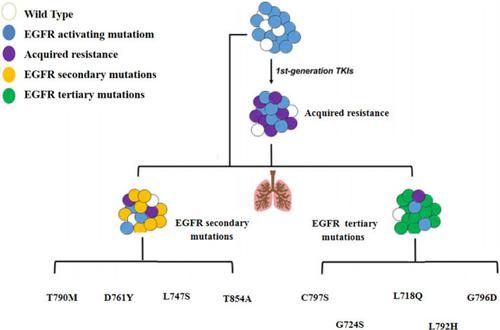当前位置:
X-MOL 学术
›
Chem. Bio. Drug Des.
›
论文详情
Our official English website, www.x-mol.net, welcomes your feedback! (Note: you will need to create a separate account there.)
EGFR degraders in non‐small‐cell lung cancer: Breakthrough and unresolved issue
Chemical Biology & Drug Design ( IF 3 ) Pub Date : 2024-04-13 , DOI: 10.1111/cbdd.14517 Jiayi Shen 1 , Liping Chen 1 , Jihu Liu 1 , Anzhi Li 1 , Lüyin Zheng 1 , Sheng Chen 2 , Yongdong Li 1
Chemical Biology & Drug Design ( IF 3 ) Pub Date : 2024-04-13 , DOI: 10.1111/cbdd.14517 Jiayi Shen 1 , Liping Chen 1 , Jihu Liu 1 , Anzhi Li 1 , Lüyin Zheng 1 , Sheng Chen 2 , Yongdong Li 1
Affiliation

|
The epidermal growth factor receptor (EGFR) has been well validated as a therapeutic target for anticancer drug discovery. Osimertinib has become the first globally accessible third‐generation EGFR inhibitor, representing one of the most advanced developments in non‐small‐cell lung cancer (NSCLC) therapy. However, a tertiary Cys797 to Ser797 (C797S) point mutation has hampered osimertinib treatment in patients with advanced EGFR‐mutated NSCLC. Several classes of fourth‐generation EGFR inhibitors were consequently discovered with the aim of overcoming the EGFRC797S mutation‐mediated resistance. However, no clinical efficacy data of the fourth‐generation EGFR inhibitors were reported to date, and EGFRC797S mutation‐mediated resistance remains an “unmet clinical need.” Proteolysis‐targeting chimeric molecules (PROTACs) obtained from EGFR‐TKIs have been developed to target drug resistance EGFR in NSCLC. Some PROTACs are from nature products. These degraders compared with EGFR inhibitors showed better efficiency in their cellular potency, inhibition, and toxicity profiles. In this review, we first introduce the structural properties of EGFR, the resistance, and mutations of EGFR, and then mainly focus on the recent advances of EGFR‐targeting degraders along with its advantages and outstanding challenges.
中文翻译:

非小细胞肺癌中的 EGFR 降解剂:突破性和未解决的问题
表皮生长因子受体(EGFR)作为抗癌药物发现的治疗靶点已得到充分验证。奥希替尼已成为全球首个可使用的第三代 EGFR 抑制剂,代表了非小细胞肺癌 (NSCLC) 治疗领域最先进的进展之一。然而,三级 Cys797 至 Ser797 (C797S) 点突变阻碍了奥希替尼治疗晚期 EGFR 突变 NSCLC 患者。随后发现了几类第四代 EGFR 抑制剂,旨在克服 EGFRC797S 突变介导的耐药性。但迄今为止,尚未报道第四代EGFR抑制剂的临床疗效数据,EGFRC797S 突变介导的耐药性仍然是“未满足的临床需求”。从 EGFR-TKI 中获得的蛋白水解靶向嵌合分子 (PROTAC) 已被开发用于靶向 NSCLC 中的耐药 EGFR。一些 PROTAC 来自天然产物。与 EGFR 抑制剂相比,这些降解剂在细胞效力、抑制和毒性方面表现出更好的效率。在这篇综述中,我们首先介绍了EGFR的结构特性、EGFR的耐药性和突变,然后重点介绍了EGFR靶向降解剂的最新进展及其优势和突出的挑战。
更新日期:2024-04-13
中文翻译:

非小细胞肺癌中的 EGFR 降解剂:突破性和未解决的问题
表皮生长因子受体(EGFR)作为抗癌药物发现的治疗靶点已得到充分验证。奥希替尼已成为全球首个可使用的第三代 EGFR 抑制剂,代表了非小细胞肺癌 (NSCLC) 治疗领域最先进的进展之一。然而,三级 Cys797 至 Ser797 (C797S) 点突变阻碍了奥希替尼治疗晚期 EGFR 突变 NSCLC 患者。随后发现了几类第四代 EGFR 抑制剂,旨在克服 EGFR



























 京公网安备 11010802027423号
京公网安备 11010802027423号